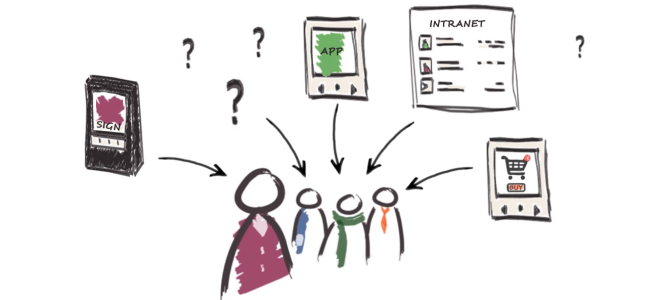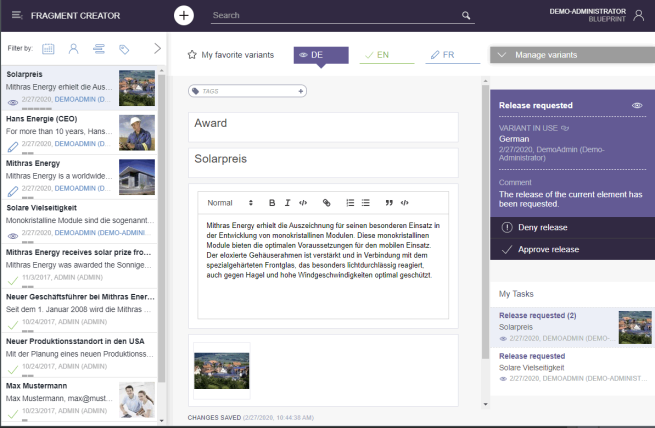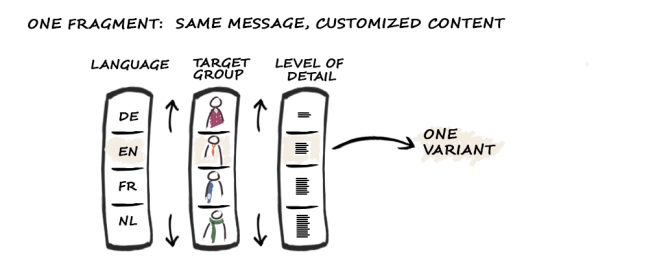 |
The FragmentCreator will no longer be supported and will no longer be available from FirstSpirit 2025.12. |
Introducing FragmentCreator
| Table of contents |
The digital revolution is increasingly transforming the way we handle information. Hardly any of today’s consumers ever bother to search for specific content and information. Instead, consumers now expect content to be retrieved and made available to them on a “context-aware” basis, in a way which is always exactly in tune with their personal interests and immediate situation.
For content providers, this mainly means having to adapt to these changes. Successful businesses must ensure that their notifications or content reaches platforms on which they will be seen by people. While communication used to be transmitted directly from the content provider to the consumer, intermediaries in the form of (external) distribution channels and platforms are now on the rise once more. The platforms and portals in which a business will have to maintain a presence vary depending on individual circumstances. Ultimately, however, it all boils down to achieving the widest possible distribution of content over all digital platforms, devices, and channels.
One problem with this is the high level of granularity of device classes and distribution channels. These include smart or connected devices in the “Internet of Things”, conventional websites, mobile apps, web shops, digital signage, social media, single-page applications, portals, and other software (e.g., in-car entertainment, wearables). More is added to the list every single day!
For content creators it means they they have no information (anymore) about
- where their content will be shown (device, channel, platform, etc.)
- how the content will be accessed (pull request, push notifications, dialog-oriented output via a digital assistant, AIs, etc.)
- how their content will be presented (visual presentation, layout, audio, etc.)
- how their content will be structured (in which context, for which target audience, etc.)
To ensure that content nevertheless fits seamlessly into all these scenarios, they must be variable and easy to digest for consumers.
A product recommendation, for example, must work just as well on digital billboards as it would in a push notification for a shopping app.
Ideally, content will have “variants” that can be issued on a context-dependent basis.
Example: A push notification can first be displayed as a single text-based message (“text” variant). Depending on how consumers respond (e.g., when scrolling), a product-related video will then be shown (“video” variant). Another option then would be to play an “audio” variant, whereby a piece of content is played over a smart loudspeaker in the consumer’s home or in their connected car.
FragmentCreator: The first client in the CXT family
FragmentCreator is the first “CXT client” which is designed from the ground up to meet the specific requirements of content creation and distribution. FragmentCreator helps authors create “modular” content that can be shown on many different devices and in a range of different contexts.
Fragments: from fixed structures to modular content
FragmentCreator saves content in format-neutral “fragments”. Thanks to their self-contained content, fragments can be created, managed, tagged, and published (e.g., using FirstSpirit CaaS) regardless of context.
Fragments:
- are small, self-contained units of content.
- are no longer fixed elements in the context of a website, but can be used in a variety of different settings.
- are heavily structured and modularized.
- are created without regard to where they will be used. The ensuing format or presentation channel is not taken into consideration. Once created, these fragments can be used in a wide range of scenarios.
- consist of a number of different variants.
Variants:
- provide the same content (or have the same core message) in a different format (e.g., for different languages, target audiences, contexts).
- differ in terms of scope, level of detail or language (simple vs. complex).
- can be created easily by copying existing content and editing it.
- can be edited and published on a case-by-case basis, i.e., without regard to its fragment or other variants (e.g., language variant “EN” is released, whereas the “FR” variant is not released).
Advantages
Benefits
Working with FragmentCreator:
- Easy to use
- Intended for an individual user
Working with fragments and variants:
- Content can be created independently of subsequent presentation format (for various devices, platforms, etc.)
- Content can be delivered on any platform
- Content can be used in many different contexts
- Content is more flexible and can be adapted for the specific needs of different target audiences
A paradigm shift:
- Focus on content rather than form
- No page or navigation structures and no presentation channels – just content
Flexible content distribution and AI-supported personalization
The focus of FirstSpirit CXT is on content creation: it is simple, content can be reused in a wide variety of contexts, and the editor can concentrate entirely on one task.
Content composition and delivery are handled by other technologies. This concept opens up the freedom to use your own systems and technologies. For example, those that are already in use in your company.
Alternatively, you can also conveniently use technologies from the FirstSpirit ecosystem: CaaS and ICE.
FirstSpirit CaaS
The effort involved in adapting content for an ever growing list of devices is a thing of the past with FirstSpirit Content as a Service (CaaS). Using a universal CaaS interface, fragments and variants (from FragmentCreator) are retrieved by any front-end system (“pull” strategy: external systems query FirstSpirit for content). This reaches every app that can be activated by the interface. Using FirstSpirit CaaS, content is distributed in a flexible way both at the company’s own level and on third-party channels.
For further information please see respective documentation.





